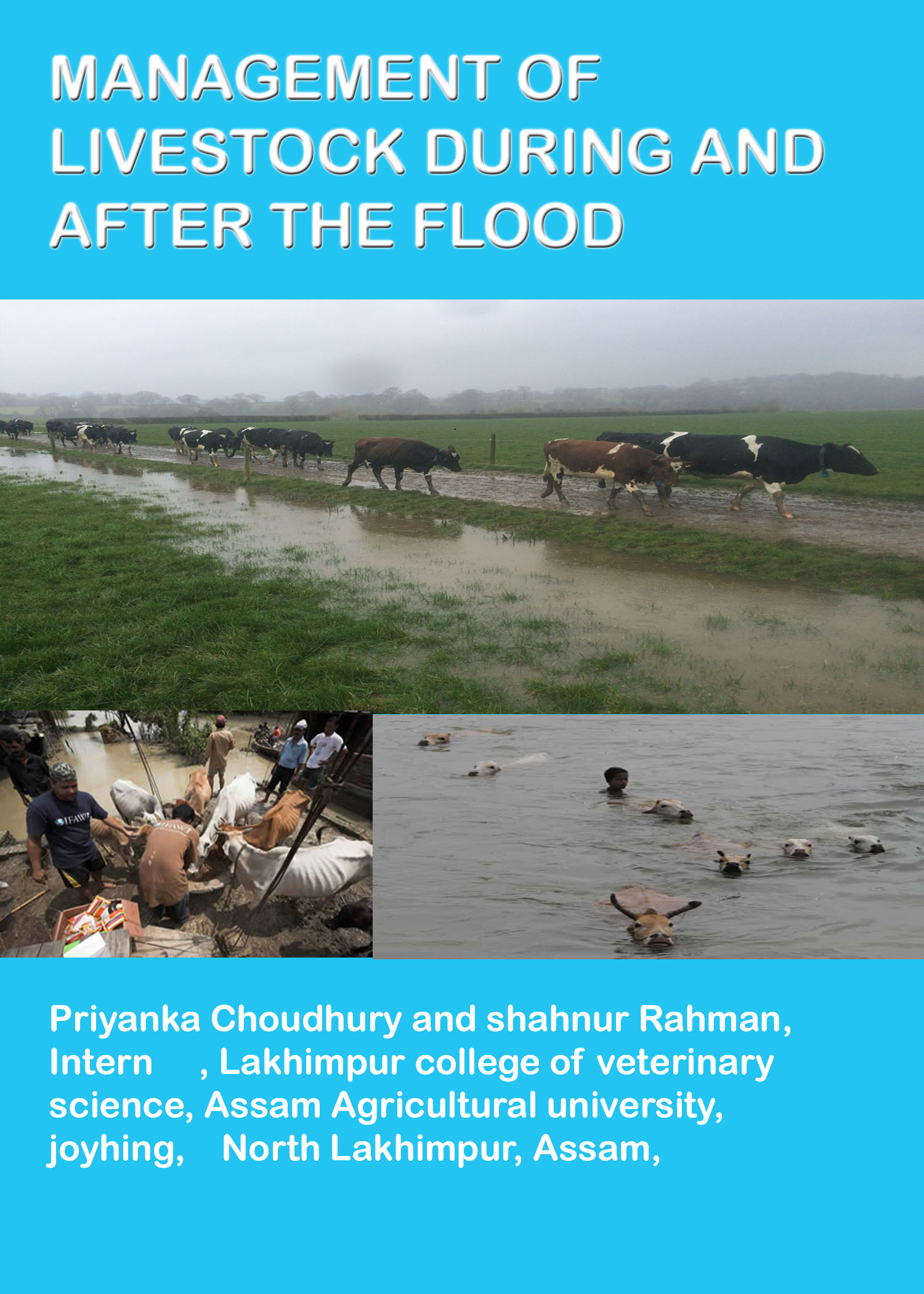MANAGEMENT OF LIVESTOCK DURING AND AFTER THE FLOOD
By- Priyanka Choudhury and shahnur Rahman, Intern
Lakhimpur college of veterinary science, Assam Agricultural university, joyhing,
North Lakhimpur, assam, 787051
Email- shahnurrahman134@gmail.com
Introduction
Flood is a type of disaster which means any type of calamities that occurs from natural or man made reasons which cannot be stopped or tracked immediately. Flood, in simple words mean a condition of over flowing of water. The common causes are overflowing of rivers, broken dams, urban drainage basins, tsunamis, deforestation, melting of snows and ices etc. In India the flood prone areas are the indo gangatic plains in the north and north east india. Assam accounts for 9.40% of total flood prone area of the country.
Damage caused by flood :
Flood occurs every year and it creates a great havoc and causes extensive damage to property, livestock, crops and human life. There is dirty and contaminated water. Shortage of drinking water for the animals. Fodder field are completely destroyed. Stock of hay or other feedalso get washed away.
The animal become shelterless and it is difficult to carry the large animals to safer places. But since animals are naturally good swimmers, they can escape drawning if they are not tied up or caged. There will be outbreak of various disease in the animals as flood transport bacteria, viruses and parasites into clean water bodies. Outflow of rivers act as breeding site for mosquitoes. Lack of food and shelter makes the animals stressed and there immunity level decreases. They become prone to many disease conditions like Haemorrhage septicemia, tetanus, dysentry, hepatitis, food poisoning, food and mouth disease, black quarter etc.
Management during flood:
- The animal should be immediately provided with adequate clean drinking water as it will prevent many disease conditions. Drinking water will keep the animal hydrated and it is important for regulation of temperature, nutrient uptake, removing wastage from the body.
- During flood scarcity of feed occurs as the crops are submerged under water. The animals should be given balanced feed along with water. Feed provides energy and nutrients to the animals. Energy requirements should be maintained in the animals for any types of quick action. Mostly roughage is preferred as it generated heat and keep the animals warm. Mouldy or contaminated feed should be avoided as it will give rise of different health issue. And special care should be taken for the pregnant animals.
- The animals should be taken to dry Highlands and temporary shelter should be made. Each animals should be checked for any injury. Injured animals should be treated first with first aid. Overcrowding should be avoided as much as possible as it will transfer diseases from one animals to another.
Disposal of dead carcasses:
- Dispose the animal within 24 hours of
- There are different methods of disposal such as incineration, rendering, landfills, burial.
1.Randering- It is the process of converting animals carcass into animals products such as meat and bone meal but it is limited because of cost of transportation and conditions of the carcasses.
- Landfills-dead animal should be disposed to licenced landfills.
- Incineration- process of burning of animal cascass at a high temperature (ie >850°c ) to inorganic ash. This is the most preferred method as it destroys all the infective agents.
- Burial method- This is the most common method. It is the process of burying the animal cascass in a pit of 7 ft inside and 9 ft deep. The cascass should be properly covered with soil and fencing should be placed to prevent entry of other animals to the burial ground. The burial site should be away from residence area and groundwater. This method is not an appropriate one in flood prone area because it may not be possible to bury the carcass in a site which do not have a sufficient distance from groundwater.
Key points to be remembered:
- It has been found that there is Increase in parasitic infestation in a post flood period because post flood favours the survival of worm eggs and larvae. Therefore anti helminthic should be given to the animals. Also take care about external parasitic infestation.
- All the animals should be observed properly for any types of injury.
- The main concern of animals during and after the flood is nutrition so complete feed blocks should be made available because during and after flood there becomes scarcity of feed.
- Provide 40-50 g of salt to adults animals and 10-20 g to small animals daily through feed.
- If possible feed the animals with hay because digestion of roughages produces heat in the body and it will keep the the animals warm if hypothermia occurs.
- Outmost care should be taken for pregnant animals. If possible make necessary arrangements to avoid any kinds of stress.
- All the animals should be vaccinated properly for commonly occuring diseases
- The infrastructure that are downed and damaged during flood should be temporarily replaced by polywire fencing. Take proper careful measures about Downed and damaged electric power lines around the house of the animal. Overcrowding of the animals should be avoided
- During flood along with water many waste materials may comes and care should be taken so that the cattle are prevented from feeding them.
References:
1.http://www.researchgate.net
2.IndianFarmer, 1(2):Management of Livestock during Flood by Nikhil Dangar, Gaurav Pandya, Mamta Janmeda, Yogesh Padheriya
- Washington state department of health;Animal disposal following a flood.
- North Dakota State university; Animal cascass disposal options.
5.https://www.pashudhanpraharee.com/management-of-livestock-during-disaster-in-india/



